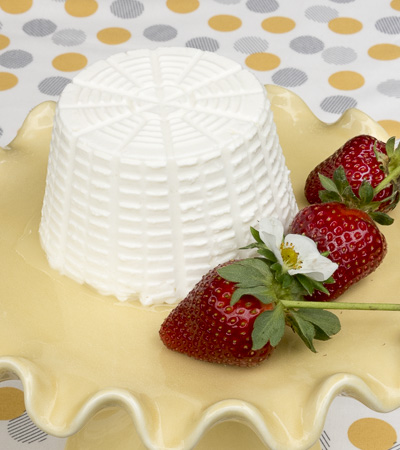Fresh Ricotta
This luscious ricotta will keep for up to 1 week, although it tastes best the first 2 or 3 days. After that, use it in cooked dishes. From My Calabria by Rosetta Costantino with Janet Fletcher (W. W. Norton). In the video below, Rosetta's mother, Maria, demonstrates the method.
- 1 gallon whole milk
- 3/4 cup heavy cream
- 2 teaspoons kosher or sea salt
- 1 teaspoon liquid vegetable or animal rennet
- Two 2-1/2-cup plastic ricotta draining baskets or a fine sieve with a 6-cup capacity
Put the milk and cream in a heavy-bottomed pot and stir to mix well. Warm the mixture over moderate heat. Remove from the heat as soon as the milk begins to foam and climb toward the top of the pot. The temperature of the milk will be 200ºF to 210°F.
Pour the milk into another pot to leave behind any scorched milk adhering to the bottom of the pot. Add the salt and stir to dissolve it.
Let the milk cool to 100°F to 105°F, which takes about 1 hour. (You can speed this process considerably by placing the pot in a bath of ice water.) In a small bowl, mix the rennet with ¼ cup cold water, then stir the diluted rennet into the pot. Let stand undisturbed until the milk has visibly thickened, about 10 minutes.
With a wooden spoon, cut a large “cross” in the milk. Stir quickly with the wooden spoon for 15 to 20 seconds to break up the coagulated milk. Using a perforated metal skimmer immersed in the milk, slowly and gently stir in one direction—so slowly that it takes about 20 seconds to make one revolution. You will see the milk begin to separate into curds and whey. Continue the slow, gentle stirring with the skimmer, moving the curds toward the center of the pot, until you have gathered a big pile of curds with whey surrounding them. (The whey may be dotted with bits of curd.). This process can take up to 5 minutes.
Slowly and gently pour off the whey, either directly into the sink or, if you want to catch every stray curd, into a cheesecloth-lined colander. Disturbing the curds as little as possible, fill the ricotta draining baskets or the fine sieve spoonful by spoonful, mounding the curd in the baskets if necessary.
If using ricotta draining baskets, set them in shallow plastic containers or on a tray to drain. If using a sieve, set it over a bowl to drain. Let stand at room temperature until the whey stops dripping from the baskets or sieve, about 2 hours, emptying the drained whey several times. The ricotta can be used immediately or refrigerated for later use. If the ricotta is in baskets, nestle the baskets in another container to catch any dripping whey, and cover the top with plastic wrap. To use, remove the plastic and invert the basket onto a plate. If the ricotta is in a sieve, invert the ricotta into a plastic container, cover, and refrigerate.
Makes 4 to 5 cups or about 2 pounds

